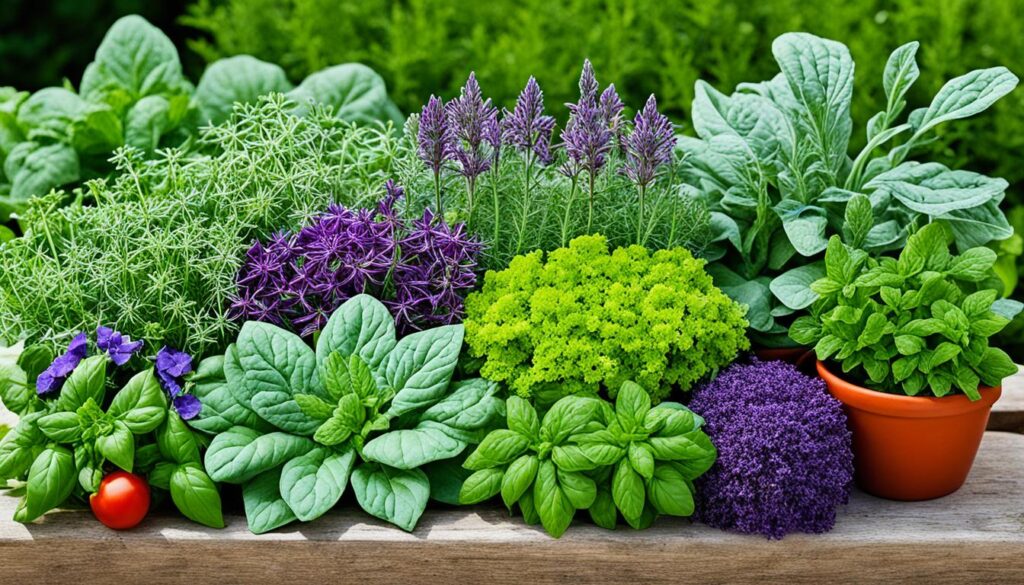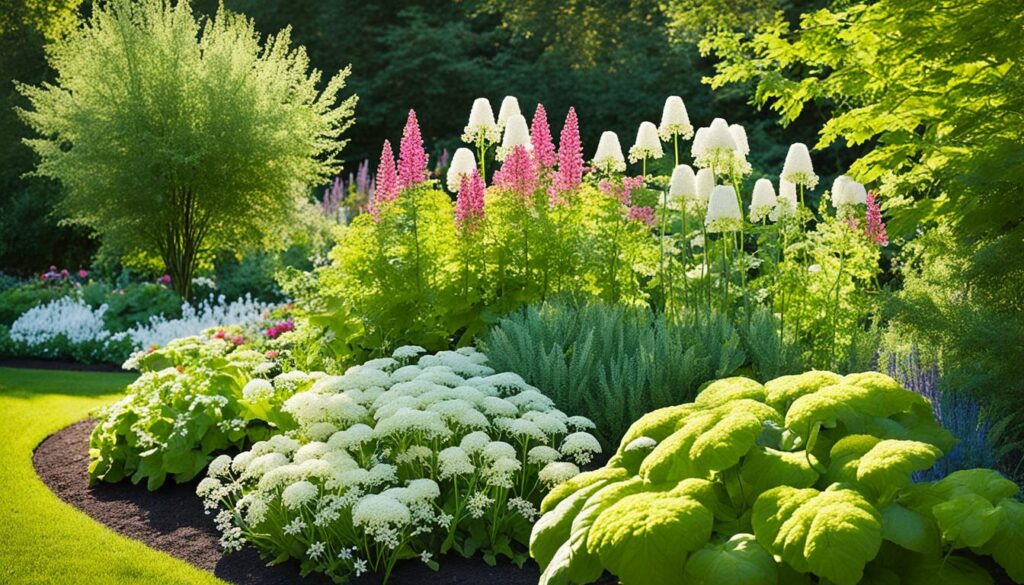Companion Planting for Flowers and Vegetables
Have you thought about growing flowers with your vegetables? Companion planting is a method that can change your garden for the better. It makes your garden a place where plants help each other out. By choosing the right flowers, you can get better pollination, keep pests away, and make your soil healthier. Plus, your garden will look more beautiful.
Key Takeaways
- Companion planting is the practice of growing plants together for mutual benefit.
- Flowers can attract beneficial insects, repel pests, and improve soil fertility for neighboring vegetables.
- Carefully selected floral companions can enhance the overall health and productivity of your garden.
- Companion planting can create a visually stunning and harmonious garden design.
- Exploring the principles of companion planting can unlock a world of possibilities for your garden.
What is Companion Planting?
Companion planting is a way to grow different plants together for mutual benefits. It’s about making a garden where plants help each other grow and stay healthy. This method creates a balanced garden ecosystem where each plant plays a role in the garden’s success.
The Principles of Plant Companionship
At its core, companion planting is about forming plant partnerships. Some plants keep pests away, attract helpful insects, offer shade, or improve soil for others. By picking the right plants to grow together, gardeners can use these natural benefits to make their gardens stronger and more productive.
Benefits of Companion Planting
- Pest deterrence: Certain plants can repel or confuse common garden pests, protecting more vulnerable crops from damage.
- Attracting beneficial insects: Flowering plants can draw in pollinators, predators, and parasitoids that help control harmful insects.
- Improved plant health: Companion plants can provide nutrients, shade, or physical support for their neighbors, enhancing their growth and resilience.
- Weed suppression: Some plants can outcompete weeds, preventing them from taking over the garden and competing for resources.
- Increased soil fertility: Cover crops and green manures can enrich the soil, making it more productive for subsequent plantings.
By using companion planting, gardeners can build a strong, balanced plant community. This method helps plants grow better and makes the garden more sustainable. It uses plant partnerships found in nature to create a thriving garden environment.
Flowers that Attract Beneficial Insects
Gardeners looking for a pest-free garden should plant flowers that draw beneficial insects. These flowers help keep pests away naturally. They are key to a healthy garden.
Borage: A Pollinator’s Paradise
Borage has beautiful blue flowers that bees and butterflies love. It’s an annual that grows easily and has lots of nectar. Adding borage to your garden helps pollinators and makes your plants do better.
Tansy: A Pest-Eating Bug Magnet
Tansy has bright yellow flowers that attract ladybugs and other helpful insects. These bugs eat pests like aphids and caterpillars. This means your garden will have fewer pests and your plants will grow better.
| Flower | Beneficial Insects Attracted | Key Benefits |
|---|---|---|
| Borage | Bees, Butterflies | Supports Pollination, Nectar-Rich |
| Tansy | Ladybugs, Lacewings, Predatory Wasps | Pest Repellent, Attracts Beneficial Bugs |
Adding these flowers to your garden helps a lot of beneficial insects. This keeps pests away and lets your plants grow well.
Pest-Repelling Floral Companions
In the world of companion planting, some flowers are great at keeping pests away. Marigolds and nasturtiums are two such flowers that are perfect for organic gardens. They offer a natural way to fight garden pests.
Marigolds: Nature’s Insecticide
Marigolds are known for keeping many garden pests away, like aphids, nematodes, beetles, and rabbits. They do this with natural insecticides called pyrethrins. By planting marigolds near your veggies or flowers, you can keep pests away naturally.
Nasturtiums: Decoy for Hungry Caterpillars
Nasturtiums are also great at keeping pests away. Their leaves and flowers taste bad to caterpillars, which keeps them away from your cabbage and kale. They act as a decoy, protecting your other plants while adding color to your garden.
Using these pest-repelling flowers in your garden means you don’t need harsh chemicals. Marigolds and nasturtiums are two of the best at keeping pests away. They help create a healthy, organic growing environment.
Flowers that Enhance Soil Health
Some flowers are more than just pretty to look at. They can also make your garden soil healthier. Phacelia, or “scorpion weed,” is one such flower. It’s a great green manure crop because you can mix it into the soil to add nutrients.
Phacelia: A Green Manure Powerhouse
Phacelia has deep roots that break up hard soil. Its many flowers also draw in beneficial insects that eat garden pests. When you mix phacelia into the soil, it breaks down and adds lots of soil-improving stuff. This includes nutrients like nitrogen, phosphorus, and potassium, making the soil better for your plants.
Adding phacelia and other soil-improving flowers to your garden uses green manure to make your soil better. This way of planting not only makes your garden look nice. It also helps create a healthier, more lively garden.
“Phacelia is a powerhouse for building healthy, nutrient-rich soil. Its deep roots and abundant blooms make it an invaluable addition to any garden.”
Companion Planting for Flowers and Vegetables: A Symbiotic Relationship
Flowers and vegetables work together in a garden through a special partnership. By picking the right flowers and vegetables to grow together, gardeners can make a garden that helps both plants do well.
Flowers help vegetables by drawing in bees and butterflies, keeping pests away, and making the soil better. Vegetables help flowers by giving them shade, support, or better growing conditions. This way, integrated flower and vegetable planting makes a symbiotic garden relationship that helps both flowers and vegetables.
For example, marigolds and nasturtiums keep pests away from vegetables. Borage and tansy bring in insects that eat pests, keeping the garden balanced.
Using flower and vegetable companions in your garden makes a space that takes care of itself and needs fewer chemicals. The symbiotic garden relationships make sure your plants grow well. They also draw in many pollinators and beneficial insects.
Herbs as Companion Plants
Herbs can be great friends in the garden, offering many benefits to nearby vegetables. By adding herbs to your vegetable garden, you can use their natural benefits to make your garden better. This creates a stronger and more productive garden.
Basil: The Tomato’s Best Friend
Basil is a perfect match for tomatoes. Its strong smell keeps away thrips and other pests that like tomatoes. Basil’s scent also hides the smell of tomatoes, making it hard for pests to find them.
This helps protect your tomatoes and can make them taste better. The two plants work together to create a garden full of life and no pests.
Garlic: A Pungent Bodyguard
Garlic is another great pest fighter for your garden. It goes well with potatoes, lettuce, and cabbages. Garlic’s strong smell confuses and keeps away aphids, spider mites, and cabbage worms.
Adding garlic to your garden creates a natural shield against pests and diseases. This can make your garden healthier and more productive.
Using herb companion plants like basil and garlic can change your garden for the better. These herbs not only keep pests away but also help your plants stay healthy. This leads to a bigger and more sustainable harvest.

Pollinator-Friendly Floral Companions
Creating a garden that draws pollinators is crucial for a healthy vegetable garden. Sunflowers are among the best flowers for bees and butterflies. They bring bright colors and attract important pollinators.
Sunflowers: Towering Beauties for Bees
Sunflowers are great for attracting pollinators to your garden. They offer lots of nectar and pollen, drawing in bees, butterflies, and more. Planting sunflowers near your veggies and herbs helps with pollination, making your plants healthier and more productive.
Sunflowers stand tall and brighten up any garden. Their big, colorful flowers give pollinators a lot to eat, keeping them busy in your garden. Plus, they bloom for a long time, providing food all season.
Choosing from classic, dwarf, or multicolored sunflowers can make your garden a haven for pollinators. These flowers not only help with your harvest but also make your garden healthier and more diverse.
Shade-Providing Floral Friends
Gardening is an art of balance. Adding the right plants to your garden can greatly improve it. One great plant is the shade-providing flower, Angelica.
Angelica: Supporting Beneficial Insects
Angelica grows tall and has lots of leaves. It can shade delicate vegetables from the sun. This flower also attracts beneficial insects like ladybugs and lacewings.
These insects eat garden pests. This helps keep your garden healthy without using harsh chemicals. Adding Angelica to your garden helps everything work together well.

“Companion planting is like a symphony, where each element plays a vital role in creating a beautiful, thriving garden.”
When planning your garden, think about adding plants like Angelica. They shade your plants and draw in beneficial insects. This makes your garden balanced and productive.
Vibrant Floral Displays in the Vegetable Garden
Creating a beautiful vegetable garden is easy with decorative companion flowers. Zinnias and cosmos are great choices to make your garden colorful and lively.
Zinnias: A Riot of Colors
Zinnias are a standout in the garden, with their bright colors that match your vegetable plants. They come in many shapes and sizes, from simple daisies to fancy double flowers. Adding zinnias to your vegetable beds makes your garden look amazing and feels joyful.
Cosmos: Enhancing Pollination
Cosmos are not just pretty; they also draw bees and butterflies, which help your vegetables grow. These flowers bloom all season, offering nectar and pollen to garden friends. Planting cosmos with your vegetables means you get beauty and a better harvest.
Using these and other decorative companion flowers, your vegetable garden becomes a colorful, thriving space. It’s both useful and beautiful.
Aromatic Floral Guardians
In the garden, aromatic companion flowers are key for natural pest control. Lavender is a standout, fighting off pests and drawing in helpful insects at the same time.
Lavender: Confusing Pests, Attracting Pollinators
Lavender’s scent is a game-changer in the garden. It keeps away pests like aphids, moths, and rabbits by hiding the smells they use to find food. This stops them from hanging around your veggies or flowers.
Lavender does more than just keep pests away. It’s a big draw for bees and butterflies, which are crucial for your garden’s health and growth. By planting lavender with your veggies and other flowers, you help pollination and keep pests at bay.
| Pest Deterrent | Pollinator Attractor |
|---|---|
| Aphids | Bees |
| Moths | Butterflies |
| Rabbits | Hummingbirds |
Adding aromatic companion flowers to your garden fights pests and boosts pollination. Lavender‘s unique scent is a key part of your organic gardening strategy. It helps keep your garden healthy, balanced, and full of life.
Conclusion: Embracing Floral Companionship
Adding different flowers to your vegetable garden makes it a thriving place. Flowers help keep pests away, draw in good bugs, and make the soil healthier. They also make your garden look better.
By choosing the right flowers and vegetables together, you can make your garden work better as a whole. This way, you get a garden that’s full of life and grows well.
Flowers and vegetables work together to make your garden better. This makes your garden look great and helps everything grow well together. It’s like a team effort in your garden.
Starting your garden with this idea in mind can make it a beautiful place. Flowers and vegetables work together to make your garden a place for pollinators and good bugs. It also means healthier soil and plants.
FAQ
What is companion planting?
What are the key benefits of companion planting?
How do flowers attract beneficial insects in the garden?
What are some examples of pest-repelling flowers?
How can flowers improve soil health in the garden?
What is the relationship between flowers and vegetables in a companion planting system?
How can herbs be used as companion plants in the vegetable garden?
What role do pollinator-friendly flowers play in the vegetable garden?
How can shade-providing flowers benefit the vegetable garden?
How can flowers enhance the aesthetic appeal of the vegetable garden?
How do aromatic flowers benefit the vegetable garden?
Source Links
- 10 Must-Have Blooms for Your 2025 Garden
- The Health Advantages of Gardening You Need to Know
- How to Create a Small Vegetable Garden Layout Plan: A Beginner’s Guide
- DIY Garden Projects for Small Spaces: Upcycling Ideas to Maximize Your Garden
- Watering Techniques for Small Gardens: Ensuring Your Plants Thrive
- Small Border Plants for Landscaping: Adding Beauty and Functionality to Your Garden
- Year-Round Small Space Gardening: Seasonal Planting Tips for Maximum Harvest
- Essential Tools for Small-Space Gardening: What You Really Need
- The Ultimate Guide to Container Vegetables: What to Grow in Small Spaces
- Budget-Friendly Gardening: How to Create a Thriving Garden on a Tight Budget
- How to Optimize Sunlight in Small Gardens: Tips for Better Plant Growth
- DIY Vertical Planters: Creative Ideas for Small Space Gardening
- Companion Planting for Small Vegetable Gardens: Boost Growth and Deter Pests
- Container Gardening Essentials: Choosing the Right Pots, Soil, and Plants
- Vertical Gardening Techniques: Maximizing Your Small Space with Climbers and Vines
- How to Build a Raised Bed Garden in a Small Backyard: Step-by-Step Guide
- The Best Vegetables for Small-Space Gardens: High-Yield Varieties You Need to Grow
- Smart Vegetable Garden Layouts for Small Spaces: Maximizing Your Green Thumb in Compact Areas
- 40. Best Practices for Managing a Sustainable Garden Year-Round
- Building a Wildlife Pond for Biodiversity
- Advanced Techniques in Sustainable Gardening
- How to Create a No-Till Garden
- The Mental Health Benefits of Gardening
- Using Technology to Enhance Sustainable Gardening
- Getting Certified Organic: Steps and Benefits

Leave a Reply